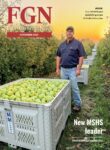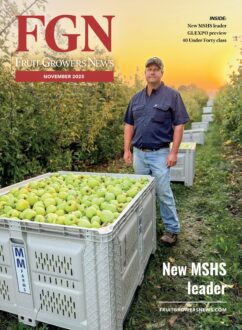
Jun 20, 2024Tenerelli Orchards exits wholesale, focuses on farmers markets, u-pick
Leaving the wholesale end of the business for direct-to-consumer sales via farmers markets proved a successful move for a Southern California tree fruit grower.
In the high desert an hour northeast of Los Angeles, Tenerelli Orchards grows peaches, cherries and other fruit that has earned a loyal customer base, including celebrities. The Littlerock, California, farm and u-pick is run by second and third generation family members.
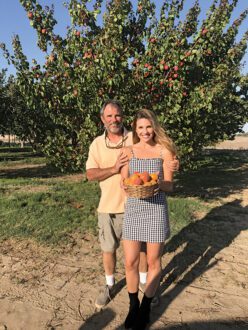
In 1932, Peter Tenerelli immigrated to Los Angeles from Italy. After retiring in 1975 from his butcher business, Tenerelli planted 10 acres of peaches. Then in 1981, frustrated by brokers and wholesalers not willing to pay the fruit’s true value, Tenerelli and his youngest son, John, began selling to Southern California farmers markets.
The switch made sorting and packing fruit in wholesale cartons unnecessary. John Tenerelli would transport the fruit in plastic field totes directly to the farmers markets, fetching $5-$10 a box instead of the 75 cents marketed wholesale.
Tenerelli Orchards has long grown peaches, nectarines and apricots. Peaches can repel rain, but growing nectarines is more challenging. Heavy summer rains and thunderstorms can destroy nectarines, marking the fruit so badly they are unmarketable. Peaches, however, aren’t as severely scarred.
Targeted harvests
John Tenerelli figured a way to grow and harvest fresh peach and nectarine varieties from July through October. Because Central Valley growers produce more volume than his region, Tenerelli strategically plants his crops.
“I have to be careful with what I grow,” he said. “I have to know what I can grow and what I can move.”
Instead of planting a limited number of varieties, Tenerelli Orchards diversified by planting 25 peach and nectarines varieties on one acre each. During the season, harvesting is constant. The staggered varieties ripen at particular times and are picked, for example, four days apart in three cycles, which provides a constant flow of fruit.
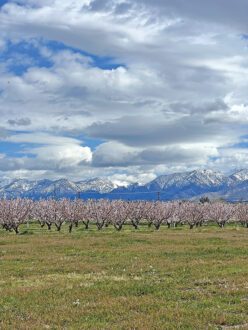
Tenerelli concedes such a system could be difficult for most growers.
“For quality, we are growing fruit a little riper than everyone else, but the main thing is keeping it fresh,” he said
Through the years, Tenerelli learned how to correctly prune peach trees. Thinning is one of the biggest costs of growing fresh-market Firestone peaches. Correct fertilizer applications that vary by variety and allow the trees to produce the proper amount of fruit, which could be 200 to 400 pieces, ensure proper fruit counts.
For cherries, Tenerelli learned how proper pruning can control harvesting too many or too few fruit. He learned from earlier mistakes and discovered that more pruning can lead to higher fruit counts.
Once properly trained, cherry trees grow well and don’t require much trimming, unlike apricots and peaches, which can be pruned as a grower wishes, Tenerelli said. The tedious work of picking is expensive and constitutes the main cost of cherries, he said.
Carefully hand laying the fruit in totes also ensures ripe fruit is being picked.
“We know when to pick peaches, when they’re ripe and don’t throw them in the picking tote, we lay them in there nicely,” Tenerelli said.
Initially planted as a bird decoy for the cherries by Tenerelli’s father in the late 1990s, Persian mulberries have joined the farm’s harvest schedule.
A downside is harvest difficulty. Workers must climb ladders, picking and turning the fruit so the berries aren’t crushed. The expensive harvest is rewarded by high prices paid by his upscale customers, wealthy individuals who reserve the fruit two weeks in advance. Tenerelli’s mulberries market for $15 for 6.5 ounce clamshells.
Because of the harvesting challenge, crews pick 50% to 75% of the mulberries, harvesting per order. Workers pick the easier to reach low- hanging fruit. To keep prices high and harvest costs lower, berries are left on the tree.
To reduce his seven-day-a-week workload from May through October harvest, Tenerelli stopped growing apples in 2020.
Farmers markets pitfalls
Because popular farmers markets don’t accept new growers, Tenerelli doesn’t recommend growers change their business models to selling exclusively at farmers markets, and instead use them as a supplemental outlet to their own farm stand sales.

“You can’t do it with just three to four farmers markets,” he said.
Being close to a city helps, Tenerelli said. Because of small margins, making the change can be tough, he said. Tenerelli Orchards sells in more than a dozen Southern California farmers markets.
The region’s lack of humidity produces less fungus and mold. Brown rot, a big peach threat, isn’t as big a concern, Tenerelli said. Pests are bigger threats in the San Joaquin Valley, with peach twig borer easily controlled in his region, Tenerelli said.
Colder high desert temperatures can destroy apricots. In the last two decades, however, fewer frosts have favored apricot blossoms, which appear earlier than peaches. Because trees prefer cooler nights and warm, dry days, high desert growing helps retain fruit on the trees longer. The fruit matures slightly better, producing better flavors than some other regions, Tenerelli said.
After learning a lot about pests through University of California Cooperative Extension courses, Tenerelli has been able to grow fruit without pest control or farm advisors.
For years, Tenerelli has deployed mating disruption. To monitor pests, pheromone traps lure pests including the harmful peach twig borers.
U-pick insights
In 2020, Tenerelli planted his first cherry u-pick orchard, opening it to customers in 2023. Apricots are also a u-pick option. Because of incorrect pruning and overcropping, the cherry trees took nine years to bear fruit and then they bore too much fruit, which almost killed the trees.
Tenerelli caters to an above-average clientele, which includes Hollywood actors, via email and a website. Tenerelli characterizes u-pick as a fun experience and said he enjoys chatting with the customers.
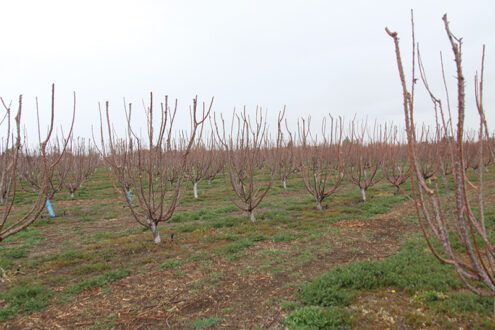
“The people who come out, they’re in such good moods,” he said. “It’s a great clientele to be around.”
Despite a previous long-term drought, Tenerelli and area growers received adequate groundwater. The 2023 saturation event helped replenish soil and the aquifer.
Freely sourced from Los Angeles businesses seeking disposal, mulch is placed under trees. On extremely hot days, mulch provides trees moisture, helping Tenerelli save 20% on water costs. A lack of mulch application machinery, however, brings costs as the mulch must be manually shoveled from trailers.
Tenerelli is grateful for his family members’ help, including his wife Tracie. Daughter Natalie and her partner Dan Cox expanded sales through online sales and delivery. Before joining his dad, John Tenerelli was in the liquor sales business and worked in Hollywood studioproduction.
He took over operations in 2002 after his father died, and said he enjoys experimenting with new varieties and seeing how they produce.
“I love the outdoors and not being inside,” he said. “With the u-pick, it’s a lot of fun. People are so happy to be around farmers, which is important. I love going to work.”
— By Doug Ohlemeier, Assistant Editor














